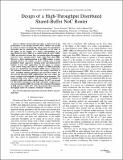Design of a high-throughput distributed shared-buffer NoC router
Author(s)
Ramanujam, Rohit Sunkam; Soteriou, Vassos; Lin, Bill; Peh, Li-Shiuan
DownloadPeh_Design of a high.pdf (1.066Mb)
PUBLISHER_POLICY
Publisher Policy
Article is made available in accordance with the publisher's policy and may be subject to US copyright law. Please refer to the publisher's site for terms of use.
Terms of use
Metadata
Show full item recordAbstract
Router microarchitecture plays a central role in the performance of an on-chip network (NoC). Buffers are needed in routers to house incoming flits which cannot be immediately forwarded due to contention. This buffering can be done at the inputs or the outputs of a router, corresponding to an input-buffered router (IBR) or an output-buffered router (OBR). OBRs are attractive because they can sustain higher throughputs and have lower queuing delays under high loads than IBRs. However, a direct implementation of an OBR requires a router speedup equal to the number of ports, making such a design prohibitive under aggressive clocking needs and limited power budgets of most NoC applications. In this paper, we propose a new router design that aims to emulate an OBR practically, based on a distributed shared-buffer (DSB) router architecture. We introduce innovations to address the unique constraints of NoCs, including efficient pipelining and novel flow-control. We also present practical DSB configurations that can reduce the power overhead with negligible degradation in performance. The proposed DSB router achieves up to 19% higher throughput on synthetic traffic and reduces packet latency by 60% on average for SPLASH-2 benchmarks with high contention, compared to a state-of-art pipelined IBR. On average, the saturation throughput of DSB routers is within 10% of the theoretically ideal saturation throughput under the synthetic workloads evaluated.
Date issued
2010-07Department
Massachusetts Institute of Technology. Department of Electrical Engineering and Computer ScienceJournal
Fourth ACM/IEEE International Symposium on Networks-on-Chip 2010 (NOCS)
Publisher
Institute of Electrical and Electronics Engineers (IEEE)
Citation
Ramanujam, Rohit Sunkam et al. “Design of a High-Throughput Distributed Shared-Buffer NoC Router.” Fourth ACM/IEEE International Symposium on Networks-on-Chip 2010 (NOCS). 69–78. © Copyright 2010 IEEE
Version: Final published version
ISBN
978-1-4244-7086-0
978-1-4244-7085-3
